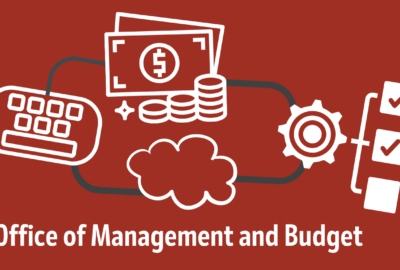Hubbard Radio Washington DC, LLC. All rights reserved. This website is not intended for users located within the European Economic Area.
OMB gives agencies a 10-year digital services transformation framework
OMB’s new guidance, Delivering a Digital-First Public Experience, seeks to accomplish the spirit and intent of the 2018 21st Century IDEA Act.
Nearly five years in the making, the time has come for the catalyst to bring agencies into the digital 21st century.
Agencies have about 100 actions to transform, evolve and standardize the citizens’ online experience under new guidance from the Office of Management and Budget.
OMB today released the Delivering a Digital-First Public Experience guidance to accomplish the spirit and intent of the 2018 21st Century IDEA Act.
“This is a 10-year transformation framework,” said Clare Martorana, the federal chief information officer, in an exclusive interview with Federal News Network. “We’re at a really important time in our community. We’ve already been working with our agency partners on many component pieces of this. But one of the great opportunities about this is with so much of the work that we are doing with our cybersecurity portfolio. We are modernizing systems. We are retiring legacy systems. The zero trust strategy is really having a material impact on the federal ecosystem, customer experience, digital experience and IT modernization are riding along with cybersecurity. You can’t separate these. Because if you’re going to modernize a system in order to put in the right security framework, you had better be designing with your users, you had better be really modernizing your entire ecosystem.”
OMB’s goal with the guidance is to drive the concept of “digital by default.”
And despite the goals of the E-Government Act of 2003, four separate and distinct OMB policies focused on agency websites, starting in 2004, a digital management strategy in 2012 and including a 2016 digital services memo and playbook, agencies have struggled to keep up with the standards and changing expectations of citizen and businesses.
The 21st Century IDEA Act, sponsored by Rep. Ro Khanna (D-Calif.) was supposed to help close the gaps. But delays in issuing the guidance through two administrations meant agency progress has been uneven.
OMB found:
- 45% of federal websites are not mobile friendly;
- 60% of federal websites have a possible accessibility issue;
- 80% of federal websites do not use U.S. Web Design System code;
- 2% of federal government forms to date have been digitized (offered as a dynamic online form, not just a fillable online PDF)
“American people should know when they’re interacting with an official government website. Today, it’s hard. You get search results and there’s hundreds, millions of search results for one question that you ask. This will actually help all Americans get clarity around if they’re interacting with a government website,” Martorana said. “We will also focus on getting the best answers to the top questions and in language that people can understand. They will be able to access government online services, no matter what their ability level is. So we will be continuing to focus on Section 508, and all of the accessibility guidelines that the team has focused on for many years. But this is really going to be catalytic in improving, and then using government websites. The public should be able to use these websites on their mobile device. We need to meet them where they currently are, in a way that works for them.”
OMB’s 100 actions, 7 categories
Martorana said that means agencies still will need multi-channel approaches where digital services must be easy and accessible, but not the only way citizens can interact. She said in-person and phone calls still play a big role, but the experience must be linked.
Mike Hettinger, president and founding principal of Hettinger Strategy Group LLC and a former House Oversight staff member, praised OMB for finally getting the guidance out the door.
“This law, which will be five years old in December, was always intended to help jump start the modernization of the technologies that support better customer experience, like modernized websites, digitized forms and expanded use of electronic signatures. The guidance released today does a good job of capturing the spirit and intent of 21st Century IDEA, with a particularly strong focus on websites and forms, and will hopefully lead to more consistent application of the requirements across government,” he said. ” I was also pleased to see the requirement for governmentwide action to make it ‘easier to buy’ the services and software that support the modernization of customer experience technology. This was always a key part of IDEA and it has been largely overlooked the last five years as we awaited guidance.”
The 100 actions are broken down across seven broad categories, including branding, analytics, design and content.
“One of the top things that we’ll be doing is identifying and assessing top public facing websites and digital services. We will be assessing common questions and top web content to make sure we eliminate duplication and that we are optimizing government content for search engine optimization (SEO),” she said. “We will also be inventorying public facing services and assess top tasks so that we can figure out if they can be digitized into self-service options for the public.”
OMB is requiring agencies to use the US Web Design System standards. Departments migrate all sites to the .gov domain and use the governmentwide automated scanning tools to identify usability issues and measure digital delivery progress.
“Analytics are really critical for us making sure that we can understand how users are utilizing these different digital properties, where we have abandoned rates, where we have opportunities to really deliver a better, more seamless experience for customers,” Martorana said. “Accessibility is a very large focus for us, making sure that Section 508 accessibility standards are followed. Brand is something that is really challenging because it is very difficult. If you’re going on a multi-agency journey, where you might have to complete tasks in 2, 3, 4 or 5 different agencies, it is very difficult if you are starting at a search engine to make sure you’re landing on accurate, credible, timely government content. It’s also very difficult when you’re moving from one website to another. If there’s not a consistent visual design it’s really hard to understand if you’re going from one trusted government website to another trusted, verified government website. That is something that is also part of this policy framework. Around content, the public shouldn’t have to decipher multiple duplicate conflicting sources of content. That’s our job.”
CIO Council’s new committee
Martorana said OMB isn’t just putting out the guidance and hoping for the best.
She said first OMB developed through a “human-centered policymaking” approach, working with agency leaders, especially given the fact every agency is in a different place in their digitalization journey.
Additionally, the CIO Council will create a new digitization committee over the next 90 days to help lead the implementation effort. She said OMB also will stand up some cross agency governance processes, communities of practices and communities of action that will help make sure that agencies are focused on implementation.
At a June hearing of the Senate Homeland Security and Governmental Affairs, former federal executives called on OMB to require agencies to name chief customer experience officers or something similar to help shepherd these and other changes from idea to implementation.
“Another way that we are really harnessing the power have this policy is marrying it with some of the work we’ve already been doing with the Technology Modernization Fund. We have funding allocated for some of this work, and making sure that we are developing the standards, playbooks and best practices that will actually bring everybody along on the journey,” she said. “We do still have the $100 million CX allocation that is available. We have not spent that down, really, at all. We were really surprised that we did not have people banging on the door trying to get their website modernization efforts moving forward. But we will continue to work on that and make sure that we are tying funding to this policy.”
Martorana and the Technology Modernization Fund Board are trying something new by encouraging agencies to submit funding proposals and use a new template.
“In collaboration with the TMF program management Office at the General Services Administration, we have developed a new streamlined process that includes pre-filled project plans to make it easier for agencies to submit initial project proposals. We are piloting the new process with two templates related to the 21st Century IDEA focused on the following: Improving web accessibility, and digitizing public-facing forms,” Martorana said in an email to the CIO Council, obtained by Federal News Network.
Hettering added agencies need to be held accountable for implementation and OMB and Congress need to work together to provide the necessary funding.
“I’ll never understand why it took nearly five years to get this guidance issued, but setting that aside, today’s guidance is an important step forward for government CX,” he said.
Martorana said her office’s experience in working with the budget folks to focus agency cybersecurity funding is a lesson they are carrying forward into the fiscal 2025 budget planning efforts.
“This needs to be a longer term roadmap, not a bunch of short term policies that people can choose to do or not to do. This is not optional. It is not optional that we are not digital by default,” she said. “It is time that we are focused on this as a community, our civic tech community and our vendor community. We have to bring everybody together, working to actually drive this change that will revolutionize the way that the American public interacts with our digital ecosystem and our government and that will help us build back trust.”
Copyright © 2024 Federal News Network. All rights reserved. This website is not intended for users located within the European Economic Area.
Jason Miller
Jason Miller is executive editor of Federal News Network and directs news coverage on the people, policy and programs of the federal government.
Follow @jmillerWFED
Related Stories
After four year delay, agencies to get 21st Century IDEA Act guidance this summer
TMF board leaders outline goals for $100M customer experience investment in agencies
Trump signs IDEA Act in bid to close ‘tech gap’ between government, private sector websites
Related Stories
-
For 21st Century IDEA Act, EIS, it’s just a matter of time Reporter's Notebook





